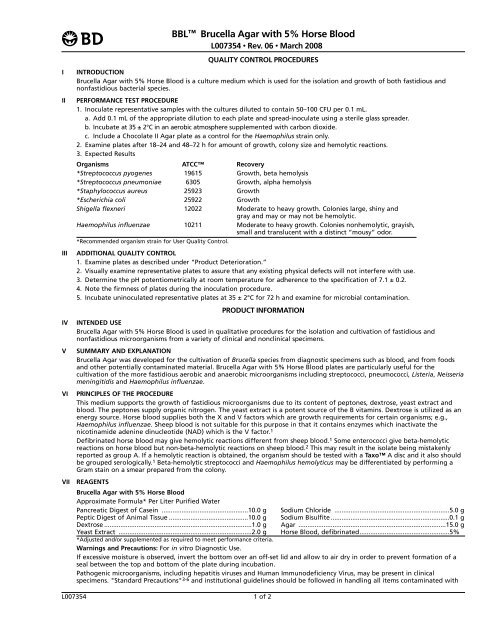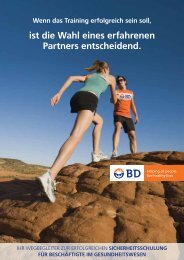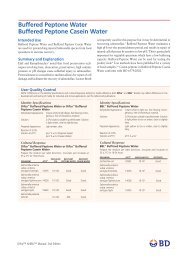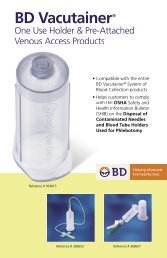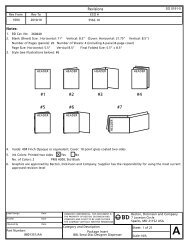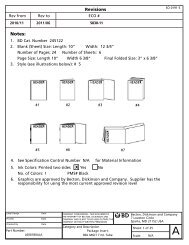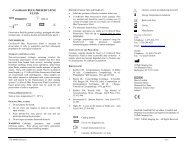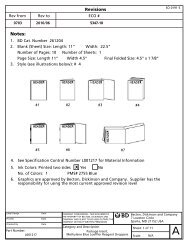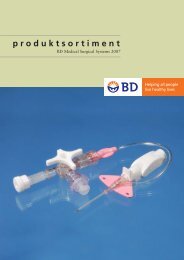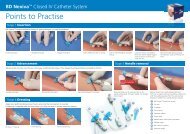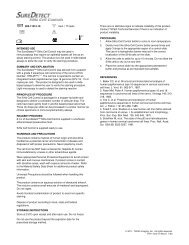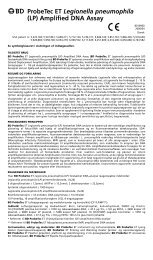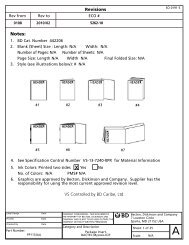BBL™ Brucella Agar with 5% Horse Blood - BD
BBL™ Brucella Agar with 5% Horse Blood - BD
BBL™ Brucella Agar with 5% Horse Blood - BD
Create successful ePaper yourself
Turn your PDF publications into a flip-book with our unique Google optimized e-Paper software.
BBL <strong>Brucella</strong> <strong>Agar</strong> <strong>with</strong> <strong>5%</strong> <strong>Horse</strong> <strong>Blood</strong><br />
L007354 • Rev. 06 • March 2008<br />
QUALITY CONTROL PROCEDURES<br />
I INTRODUCTION<br />
<strong>Brucella</strong> <strong>Agar</strong> <strong>with</strong> <strong>5%</strong> <strong>Horse</strong> <strong>Blood</strong> is a culture medium which is used for the isolation and growth of both fastidious and<br />
nonfastidious bacterial species.<br />
II PERFORMANCE TEST PROCEDURE<br />
1. Inoculate representative samples <strong>with</strong> the cultures diluted to contain 50–100 CFU per 0.1 mL.<br />
a. Add 0.1 mL of the appropriate dilution to each plate and spread-inoculate using a sterile glass spreader.<br />
b. Incubate at 35 ± 2°C in an aerobic atmosphere supplemented <strong>with</strong> carbon dioxide.<br />
c. Include a Chocolate II <strong>Agar</strong> plate as a control for the Haemophilus strain only.<br />
2. Examine plates after 18–24 and 48–72 h for amount of growth, colony size and hemolytic reactions.<br />
3. Expected Results<br />
Organisms ATCC Recovery<br />
*Streptococcus pyogenes 19615 Growth, beta hemolysis<br />
*Streptococcus pneumoniae 6305 Growth, alpha hemolysis<br />
*Staphylococcus aureus 25923 Growth<br />
*Escherichia coli 25922 Growth<br />
Shigella flexneri 12022 Moderate to heavy growth. Colonies large, shiny and<br />
gray and may or may not be hemolytic.<br />
Haemophilus influenzae 10211 Moderate to heavy growth. Colonies nonhemolytic, grayish,<br />
small and translucent <strong>with</strong> a distinct “mousy” odor.<br />
*Recommended organism strain for User Quality Control.<br />
III ADDITIONAL QUALITY CONTROL<br />
1. Examine plates as described under “Product Deterioration.”<br />
2. Visually examine representative plates to assure that any existing physical defects will not interfere <strong>with</strong> use.<br />
3. Determine the pH potentiometrically at room temperature for adherence to the specification of 7.1 ± 0.2.<br />
4. Note the firmness of plates during the inoculation procedure.<br />
5. Incubate uninoculated representative plates at 35 ± 2°C for 72 h and examine for microbial contamination.<br />
PRODUCT INFORMATION<br />
IV INTENDED USE<br />
<strong>Brucella</strong> <strong>Agar</strong> <strong>with</strong> <strong>5%</strong> <strong>Horse</strong> <strong>Blood</strong> is used in qualitative procedures for the isolation and cultivation of fastidious and<br />
nonfastidious microorganisms from a variety of clinical and nonclinical specimens.<br />
V SUMMARY AND EXPLANATION<br />
<strong>Brucella</strong> <strong>Agar</strong> was developed for the cultivation of <strong>Brucella</strong> species from diagnostic specimens such as blood, and from foods<br />
and other potentially contaminated material. <strong>Brucella</strong> <strong>Agar</strong> <strong>with</strong> <strong>5%</strong> <strong>Horse</strong> <strong>Blood</strong> plates are particularly useful for the<br />
cultivation of the more fastidious aerobic and anaerobic microorganisms including streptococci, pneumococci, Listeria, Neisseria<br />
meningitidis and Haemophilus influenzae.<br />
VI PRINCIPLES OF THE PROCEDURE<br />
This medium supports the growth of fastidious microorganisms due to its content of peptones, dextrose, yeast extract and<br />
blood. The peptones supply organic nitrogen. The yeast extract is a potent source of the B vitamins. Dextrose is utilized as an<br />
energy source. <strong>Horse</strong> blood supplies both the X and V factors which are growth requirements for certain organisms; e.g.,<br />
Haemophilus influenzae. Sheep blood is not suitable for this purpose in that it contains enzymes which inactivate the<br />
nicotinamide adenine dinucleotide (NAD) which is the V factor. 1<br />
Defibrinated horse blood may give hemolytic reactions different from sheep blood. 1 Some enterococci give beta-hemolytic<br />
reactions on horse blood but non-beta-hemolytic reactions on sheep blood. 2 This may result in the isolate being mistakenly<br />
reported as group A. If a hemolytic reaction is obtained, the organism should be tested <strong>with</strong> a Taxo A disc and it also should<br />
be grouped serologically. 1 Beta-hemolytic streptococci and Haemophilus hemolyticus may be differentiated by performing a<br />
Gram stain on a smear prepared from the colony.<br />
VII REAGENTS<br />
<strong>Brucella</strong> <strong>Agar</strong> <strong>with</strong> <strong>5%</strong> <strong>Horse</strong> <strong>Blood</strong><br />
Approximate Formula* Per Liter Purified Water<br />
Pancreatic Digest of Casein ................................................10.0 g Sodium Chloride ................................................................5.0 g<br />
Peptic Digest of Animal Tissue ............................................10.0 g Sodium Bisulfite ..................................................................0.1 g<br />
Dextrose ..................................................................................1.0 g <strong>Agar</strong> ..................................................................................15.0 g<br />
Yeast Extract ..........................................................................2.0 g <strong>Horse</strong> <strong>Blood</strong>, defibrinated..................................................<strong>5%</strong><br />
*Adjusted and/or supplemented as required to meet performance criteria.<br />
Warnings and Precautions: For in vitro Diagnostic Use.<br />
If excessive moisture is observed, invert the bottom over an off-set lid and allow to air dry in order to prevent formation of a<br />
seal between the top and bottom of the plate during incubation.<br />
Pathogenic microorganisms, including hepatitis viruses and Human Immunodeficiency Virus, may be present in clinical<br />
specimens. "Standard Precautions" 3-6 and institutional guidelines should be followed in handling all items contaminated <strong>with</strong><br />
L007354 1 of 2
lood and other body fluids. After use, prepared plates, specimen containers and other contaminated materials must be<br />
sterilized by autoclaving before discarding.<br />
Biosafety Level 2 practices, containment equipment and facilities are recommended for activities <strong>with</strong> clinical specimens of<br />
human or animal origin containing or potentially containing pathogenic <strong>Brucella</strong> spp. Biosafety Level 3 practices, containment<br />
equipment and facilities are recommended for all manipulations of cultures of the pathogenic <strong>Brucella</strong> spp. and for<br />
experimental animal studies. 5<br />
Storage Instructions: On receipt, store plates in the dark at 2-8°C. Avoid freezing and overheating. Do not open until ready to<br />
use. Minimize exposure to light. Prepared plates stored in their original sleeve wrapping at 2-8°C until just prior to use may be<br />
inoculated up to the expiration date and incubated for recommended incubation times. Allow the medium to warm to room<br />
temperature before inoculation.<br />
Product Deterioration: Do not use plates if they show evidence of microbial contamination, discoloration, drying, cracking or<br />
other signs of deterioration.<br />
VIII SPECIMEN COLLECTION AND HANDLING<br />
Specimens suitable for culture may be handled using various techniques. For detailed information, consult appropriate texts. 1,7<br />
Specimens should be obtained before antimicrobial therapy has been administered. Provision must be made for prompt<br />
delivery to the laboratory.<br />
IX PROCEDURE<br />
Material Provided: <strong>Brucella</strong> <strong>Agar</strong> <strong>with</strong> <strong>5%</strong> <strong>Horse</strong> <strong>Blood</strong><br />
Materials Required But Not Provided: Ancillary culture media, reagents, quality control organisms and laboratory equipment as<br />
required.<br />
Test Procedure: Observe aseptic techniques.<br />
The agar surface should be smooth and moist, but <strong>with</strong>out excessive moisture.<br />
Streak the specimen as soon as possible after it is received in the laboratory. The streak plate is used primarily to isolate pure<br />
cultures from specimens containing mixed flora.<br />
Alternatively, if material is being cultured directly from a swab, roll the swab over a small area of the surface at the edge; then<br />
streak from this inoculated area.<br />
Since many pathogens require carbon dioxide on primary isolation, plates may be incubated in an atmosphere containing<br />
approximately <strong>5%</strong> CO2 .<br />
Incubate plates at 35± 2°C for 18–24 h in an aerobic atmosphere supplemented <strong>with</strong> carbon dioxide.<br />
User Quality Control: See "Quality Control Procedures."<br />
Quality control requirements must be performed in accordance <strong>with</strong> applicable local, state and/or federal regulations or<br />
accreditation requirements and your laboratory's standard Quality Control procedures. It is recommended that the user refer to<br />
pertinent CLSI (formerly NCCLS) guidance and CLIA regulations for appropriate Quality Control practices.<br />
X RESULTS<br />
After incubation, most plates will show an area of confluent growth. Because the streaking procedure is, in effect, a “dilution”<br />
technique, diminishing numbers of microorganisms are deposited on the streaked areas. Consequently, one or more of these<br />
areas should exhibit isolated colonies of the organisms contained in the specimen. Further, growth of each organism may be<br />
semi-quantitatively scored on the basis of growth in each of the streaked areas.<br />
XI LIMITATION OF THE PROCEDURE<br />
For identification, organisms must be in pure culture. Morphological, biochemical, and/or serological tests should be performed<br />
for final identification. Consult appropriate texts for detailed information and recommended procedures. 1,7,8<br />
XII AVAILABILITY<br />
Cat. No. Description<br />
221547 BBL <strong>Brucella</strong> <strong>Agar</strong> <strong>with</strong> <strong>5%</strong> <strong>Horse</strong> <strong>Blood</strong>, Pkg. of 20 plates<br />
221548 BBL <strong>Brucella</strong> <strong>Agar</strong> <strong>with</strong> <strong>5%</strong> <strong>Horse</strong> <strong>Blood</strong>, Ctn. of 100 plates<br />
XIII REFERENCES<br />
1. Murray, P.R., E.J. Baron, J.H. Jorgensen, M.L. Landry and M.A. Pfaller (ed.). 2007. Manual of clinical microbiology, 9th ed. American Society for<br />
Microbiology, Washington, D.C.<br />
2. Teixeira, L.M. and R.R. Facklam. 2003. Enterococcus, p. 422-433. In P.R. Murray, E.J. Baron, J.H. Jorgensen, M.A. Pfaller, and R.H. Yolken (ed.),<br />
Manual of clinical microbiology, 8th ed. American Society for Microbiology, Washington, D.C.<br />
3. Clinical and Laboratory Standards Institute. 2005. Approved Guideline M29-A3. Protection of laboratory workers from occupationally acquired<br />
infections, 3rd ed. CLSI, Wayne, PA.<br />
4. Garner, J.S. 1996. Hospital Infection Control Practices Advisory Committee, U.S. Department of Health and Human Services, Centers for Disease<br />
Control and Prevention. Guideline for isolation precautions in hospitals. Infect. Control Hospital Epidemiol. 17:53-80.<br />
5. U.S. Department of Health and Human Services. 1999. Biosafety in microbiological and biomedical laboratories, HHS Publication (CDC), 4th ed.<br />
U.S. Government Printing Office, Washington, D.C.<br />
6. Directive 2000/54/EC of the European Parliament and of the Council of 18 September 2000 on the protection of workers from risks related to<br />
exposure to biological agents at work (seventh individual directive <strong>with</strong>in the meaning of Article 16(1) of Directive 89/391/EEC). Official<br />
Journal L262, 17/10/2000, p. 0021-0045.<br />
7. Forbes, B.A., D.F. Sahm, and A.S. Weissfeld. 2002. Bailey and Scott's diagnostic microbiology, 11th ed. Mosby, Inc., St. Louis.<br />
8. Isenberg, H.D. (ed.). 2004. Clinical microbiology procedures handbook, vol. 1, 2 and 3, 2nd ed. American Society for Microbiology,<br />
Washington, D.C.<br />
Becton, Dickinson and Company<br />
7 Loveton Circle<br />
Sparks, Maryland 21152 USA<br />
800-638-8663<br />
ATCC is a trademark of the American Type Culture Collection.<br />
<strong>BD</strong>, <strong>BD</strong> Logo, BBL and Taxo are trademarks of Becton, Dickinson and Company. ©2008 <strong>BD</strong>.<br />
L007354 2 of 2


